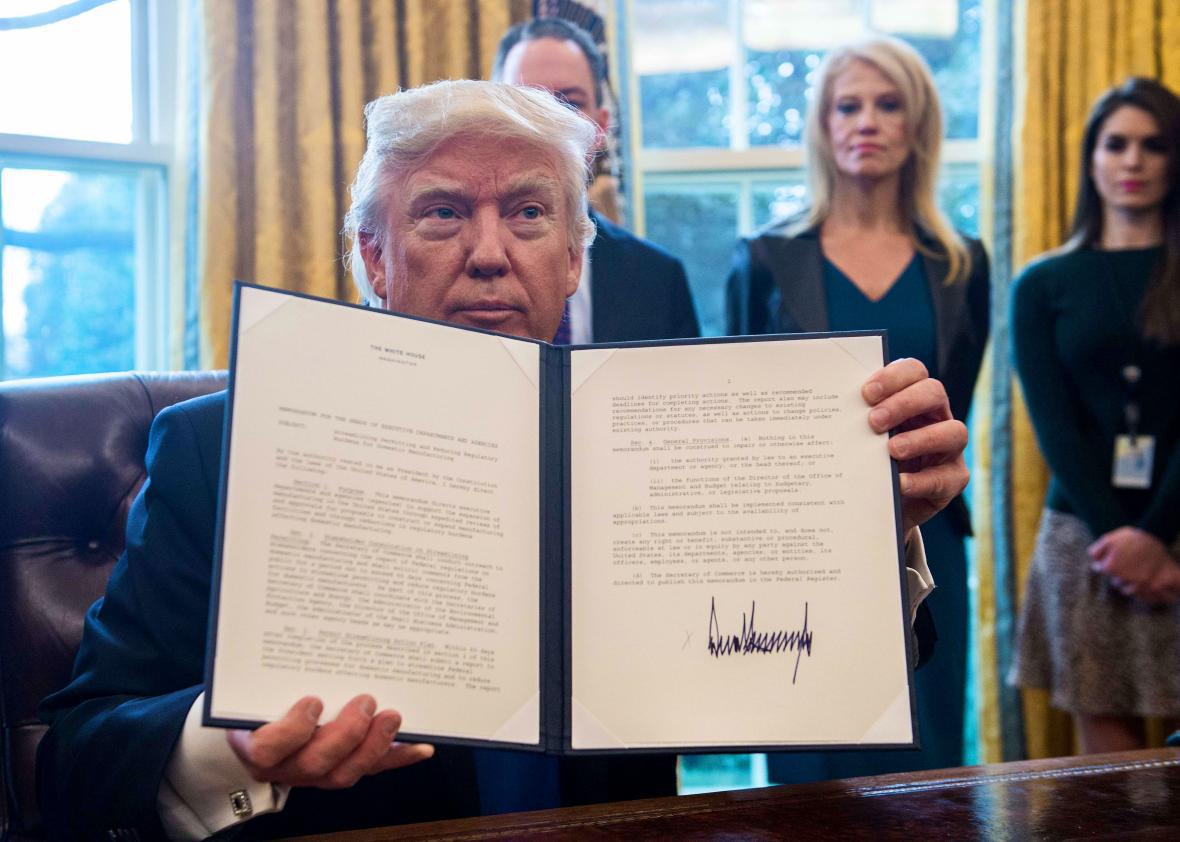On Tuesday, President Donald Trump signed executive orders that will allow the Keystone XL and Dakota Access Pipeline projects to move forward, as he assured voters he would do on the campaign trail. Both of these projects were halted by the Obama administration and have been widely criticized by activists. As Reuters reports:
[A] restart of the projects would mark a defeat for Native American tribes affected by the $3.8 billion Dakota Access pipeline. Protesters had rallied for months against plans to route the $3.8 billion pipeline beneath a lake near the Standing Rock Sioux reservation, saying it threatened water resources and sacred Native American sites.
Environmental activists broadly opposed the Keystone XL pipeline and campaigned against it for more than seven years.
The U.S. Army Corps of Engineers in January said it would begin an environmental assessment that could delay the Dakota project further. It was not clear if Trump’s order supersedes that move.
In November 2015, Trump said he would approve the Keystone XL pipeline on the condition that the United States government would receive 25 percent of the profits. He reiterated this proposal in May. Tuesday’s executive order, which invites Keystone developer TransCanada to resubmit its application for a construction permit from the State Department, includes no such stipulations.
The Keystone XL project, which will take 800,000 barrels of oil a day from Canada to the Gulf Coast, was the subject of a largely symbolic battle waged by climate activists opposed to the continued development of fossil fuel infrastructure. It was torpedoed by President Obama in 2015, a month before the Paris Climate Summit. “America is now a global leader when it comes to taking serious action to fight climate change,” he said upon rejecting a permit for the pipeline’s construction. “And frankly, approving this project would have undercut that global leadership.”
Construction of the Dakota Access Pipeline, which will carry 470,000 barrels per day across the Dakotas into Iowa and Illinois was halted after the U.S. Army Corps of Engineers denied Energy Transfer Partners, the company behind the pipeline, permission to tunnel under a portion of land north of the Standing Rock Sioux reservation without further environmental impact assessments. Construction of the pipeline was close to completion before protests against it halted progress.
Trump used to be invested in Energy Transfer Partners, the company developing the Dakota Access Pipeline, but he sold his $50,000 stake last summer. Energy Transfer Partners CEO Kelcy Warren donated $100,000 to the Trump Victory Fund, a joint fundraising effort by the Trump campaign, the Republican National Committee, and state Republican parties.
Despite Trump’s framing of the pipelines as job creators, the economic benefits of both are minimal. In signing the order approving Keystone XL, Trump said the pipeline would create 28,000 jobs. In fact, a 2014 State Department report found that the pipeline would create 35 permanent jobs post-building, with a mix of 42,100 temporary and nonconstruction jobs created over the course of the pipeline’s construction. As Jonathan Thompson wrote in November, the economic impact of the Dakota Access Pipeline will be similar:
Construction on the pipeline is about 85 percent complete and it has, indeed, put people to work. Yet it is not clear how many new jobs have been created since the jobs are spread out over 1,000 miles. Rural towns along the pipeline’s corridor have reported a boost in hotel and campground occupancy rates as the contractors move through. That, in turn, generates sales and lodging tax revenues for the local governments. The boost, however, won’t last. In a few months, when (and if) construction is complete, the workers and their spending money will depart. The finished pipeline will require just 40 permanent maintenance and operational jobs along its entire stretch.
Thompson also writes that the Dakota pipeline will not spur domestic production enough to measurably offset the 5.2 million barrels of oil the United States imports each day and will thus fail to bring America substantially closer to energy independence. Keystone XL’s completion would similarly do little to insulate the United States from the volatility of global oil prices. And, of course, both projects reinforce American dependence on carbon-emitting fossil fuels.
Trump’s approval of the pipelines will mainly accomplish two things—deliver profits to their backers and deliver a base-satisfying blow to environmentalists and activists concerned over the pipelines’ impacts on surrounding lands and carbon emissions. “If, for the first time, this nation can listen and hear us, they’ll understand that this is about climate change,” Standing Rock Sioux chairman David Archambault II said in December. “We all have to take a good look at ourselves and say, ‘Are we dependent on fossil fuels?’ If we say yes, we’re creating the demand for the Dakota Access Pipeline and for future pipelines.” On Tuesday, Trump said yes.
